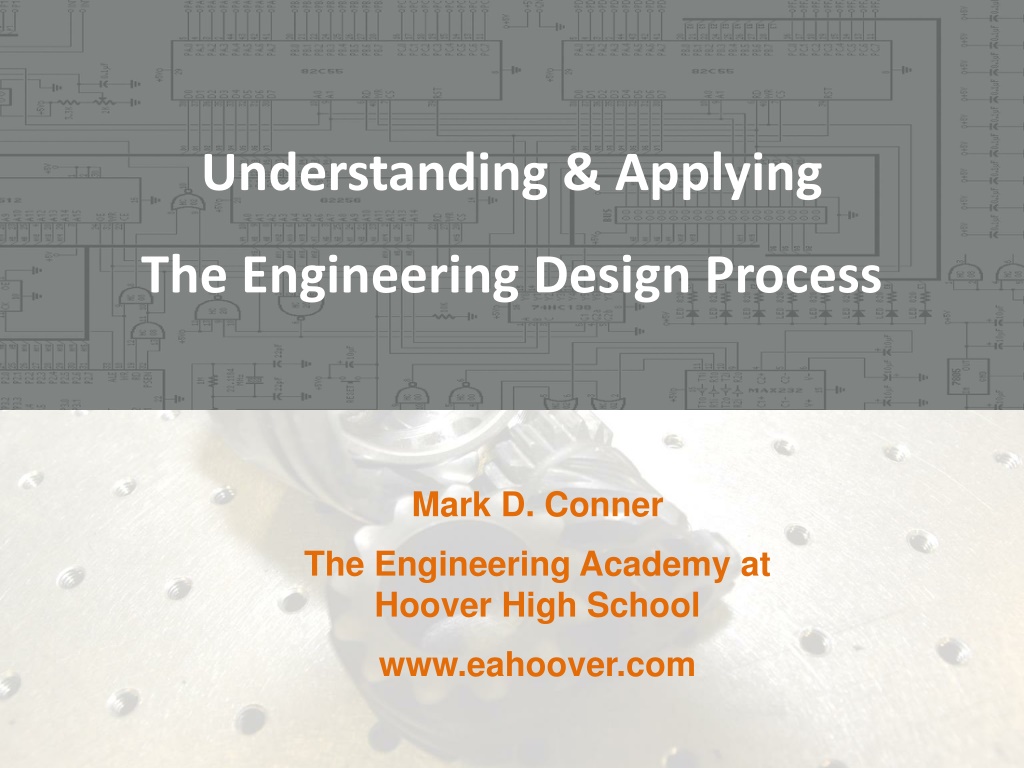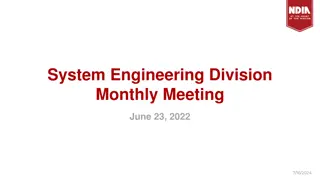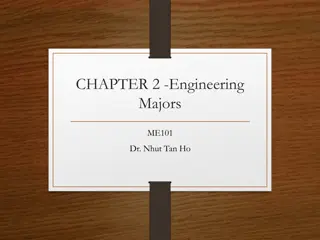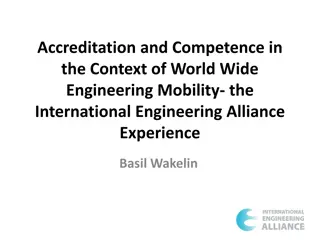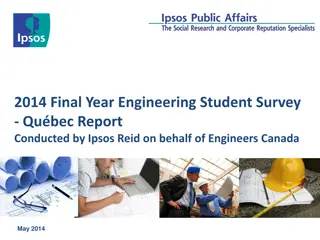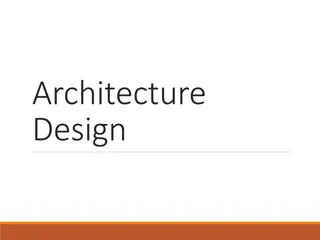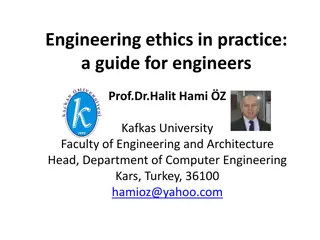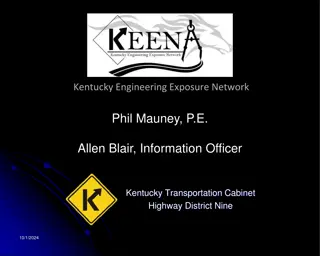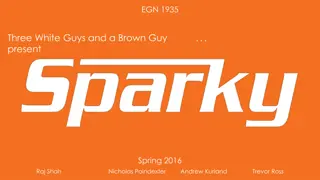Understanding and Applying the Engineering Design Process
Delve into the principles of the Engineering Design Process as outlined by Mark D. Conner from the Engineering Academy at Hoover High School. Discover the significance of problem-solving steps, design objectives, constraints, and functions in creating successful products. Learn how to define problems, establish requirements, and make crucial design decisions to achieve form, function, and originality in your engineering projects.
Download Presentation

Please find below an Image/Link to download the presentation.
The content on the website is provided AS IS for your information and personal use only. It may not be sold, licensed, or shared on other websites without obtaining consent from the author. Download presentation by click this link. If you encounter any issues during the download, it is possible that the publisher has removed the file from their server.
E N D
Presentation Transcript
Understanding & Applying The Engineering Design Process Mark D. Conner The Engineering Academy at Hoover High School www.eahoover.com
A good product is the result of a good process. + + What is design? What is the Engineering Design Process? Examples help What tools are available?
Design is about creating form and function. It s achieving objectives within given constraints.
The Engineering Design Process is an algorithm for creation and invention.
What is the Engineering Design Process?
The Engineering Design Process mirrors standard steps in problem-solving. Problem Definition (Analysis) Conceptual Design (Synthesis) Preliminary Design (Evaluation) Design Decision (Decision ) Detailed Design (Action) Documentation is crucial!
Define the problem in detail without implying a particular solution. desired attributes and behavior expressed as being statements (not doing ) Problem Definition restrictions or limitations on a behavior, a value, or some other aspect of performance stated as clearly defined limits often the result of guidelines and standards Clarify design objectives Identify constraints Establish functions Establish requirements actions the design must perform expressed as doing statements typically involve output based on input non-negotiable objectives and/or functions
Objectives, constraints, functions and requirements may be broad-based. Some items are absolute others may be negotiable Functionality (inputs, outputs, operating modes) Performance (speed, resolution) Cost Ease of use Reliability, durability, security Physical (size, weight, temperature) Power (voltage levels, battery life) Conformance to applicable standards Compatibility with existing product(s)
Both functional and non-functional requirements may be placed on a design. Functional requirements: support a given load respond to voice commands (output based on input) Non-functional requirements (usually form-focused): size, weight, color, etc. power consumption reliability durability etc.
Design involves creativity within boundaries. Consider any viable solution concept. precise descriptions of properties numerical values corresponding to performance parameters and attributes Conceptual Design Establish design specifications Generate design alternatives must live within the design space let the creativity flow don t marry the first idea beware of you/we can t and you/we have to
Nail down enough design details that a decision can be made. cardboard or scale models computer models (CAD, FEM) mathematical models Preliminary Design Flesh out leading conceptual designs Model, analyze, test, and evaluate conceptual designs designs Flesh out leading Flesh out leading conceptual designs Model Model, analyze Model, analyze, test evaluate conceptual Flesh out leading conceptual designs conceptual designs Model, analyze, test, and Flesh out leading conceptual designs qualitative and/or quantitative proof-of-concept simulation results determine the optimal design
The optimal design solution may or may not be obvious. Design Decision Select the optimal design based on the findings from the previous stage
Time to go from idea to reality. Detailed Design Refine and optimize choices made in preliminary design Articulate specific parts and dimensions Fabricate prototype and move toward production There is a huge gulf between a great idea and a working prototype!
The Engineering Design Process is generally iterative, not linear. Problem Definition (Analysis) Conceptual Design (Synthesis) Preliminary Design (Evaluation) Design Decision (Decision ) Detailed Design (Action)
How is the Engineering Design Process applied? (Part 1 Asking Questions) Context: BEST Robotics
The design process begins with some initial problem statement. Initial Problem Statement Design a robot to play this year s game. Design problems are often ill-structured and open- ended. Asking questions is a great way to begin defining the problem to be addressed.
Think in terms of questions that would help define the problem and guide the design. What scoring strategy will we use? What type of steering is desired? How many degrees-of-freedom does the robot need? What maximum reach must the robot have? How fast does the robot need to be? How much weight must the robot lift? What physical obstacles must the robot overcome? Will the robot be interacting with other robots? What sight (or other) limitations will be placed on the driver? What functions must the robot perform?
Begin to categorize questions in terms of what information the answers communicate. Problem Definition Clarifying objectives What scoring strategy will be adopted? How much practice time will drivers have? Identifying constraints Can the robot touch other robots? Can game pieces touch the field? What are the dimensions of key parts of the field? Establishing functions What scoring strategy will be adopted? How much ground must the robot cover in a round? Establishing requirements What minimum size must the robot be to carry a given game piece? How much weight must be lifted to carry a given game piece?
Think about specific details and various means of achieving certain functions. Conceptual Design Establishing design specifications What is the maximum torque required to pick up a game piece? What is the maximum reach needed? What is the smallest space in which the robot will operate? Generating design alternatives Could the robot have 2, 3, or 4 wheels? Treads? Could game pieces be lifted from above or scooped from below?
What tools are available to aid in the Engineering Design Process? How is the Engineering Design Process applied? (Part 2 Some Tools to Guide the Process)
Some simple tools can help organize the design process. (Questions List) Attributes List Pairwise Comparison Chart Objectives/Constraints Tree Problem Definition Design Specifications 6-3-5 Method Conceptual Design Preliminary Design Function-Means Tree
An Attributes List contains a list of objectives, constraints, Problem Definition Objectives Assemble primary subassemblies on the warehouse rack Make no more than 2 trips into/out of the warehouse Move planes to flight area (without hanging them) Simple controls Constraints 24 rules (size & weight) Less that 6 inches of clearance between racks Approximately 6 inches of clearance bringing the plane through the warehouse door Driver doesn t have depth perception w/r/t racks
functions, and requirements. Problem Definition Functions Grab all 4 warehouse subassemblies (individually) with one grabber Rotate fuselage 90 degrees Zero-radius turning Move FOD out of the way Requirements Be able to open the switch Reach the top, back airplane piece Support the weight of a fully assembled plane
A Pairwise Comparison Chart allows the designer to order/rank the objectives Problem Definition 0 if column objective > row objective 1 if row objective > column objective Higher score = more important Drive Power Lifting Power Simple Controls Goals Speed DOF Score Speed 0 0 0 0 0 Drive Power 1 1 1 1 4 Lifting Power 1 0 1 1 3 DOF 1 0 0 1 2 Simple Controls 1 0 0 0 1
An Objectives/Constraints Tree provides a hierarchical view of key attributes. Clear 1x4 Move FOD Move around field Zero-radius turning 24-inch door Robot Design Grab individual parts Place w/o disturbing wings Rotate fuselage Horizontal clearance Manipulate Subassemblies 6-inch clearance Release/place parts Lift entire airplane
Design Specifications refer to quantified values. Conceptual Design Wheel diameter = 8-10 inches Degrees-of-freedom = 5 Minimum grabber spacing = 1 inch Maximum grabber spacing = 4 inches Maximum weight to be lifted = 18 oz. Maximum vertical reach = 28 inches Maximum horizontal reach = 12 inches
The 6-3-5 Method is one way to begin generating design alternatives. Preliminary Design 6 team members 3 ideas each (described in words or pictures) 5 other team members review each design idea No discussions allowed during the process Can be modified to N 3 (N-1)
A Function-Means Tree shows means for achieving primary functions and the fallout. Preliminary Design Move around the field Zero-radius turning Car-type steering Treads (tank style) Two drive wheels Steering mechanism Drive motor for each tread 2-4 wheels for each tread 1-2 casters Drive wheel(s) Sturdy tread One motor per wheel Power wheel directly Power axle Single rotating wheel Rack & pinion Rigid bar linkage Power one end of tread Power both ends of tread Linkage to turn two wheels together Tread capable of turning wheels
A Function-Means Tree shows means for achieving primary functions and the fallout. Preliminary Design IGNITE LEAFY MATERIALS Electrically Heated Wire Focused Sunlight Laser Flame Protect users from post-usage burns Control flame Supply fuel for flame Convert electricity to heat Generate electric current Apply heat to leafy materials Store fuel Ignite fuel Butane Gasoline Miniature heat pump Resistive wire Electrical resistance Spark Wall-outlet-based system Battery-based system Control electrical current Convert chemical energy to electrical current Store electricity Protect electric current from flame Generate electric current Function Means
